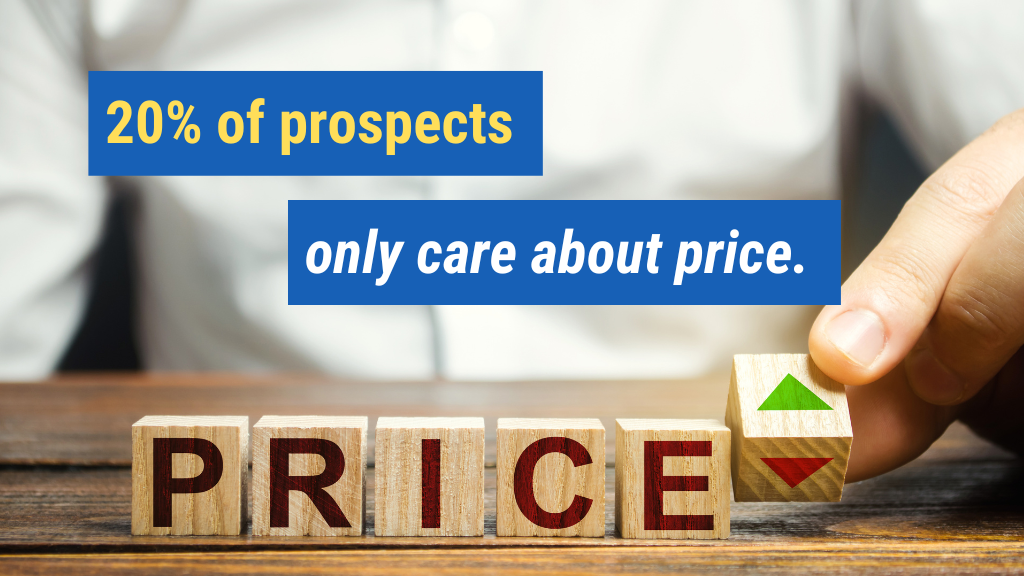Ever find yourself in a selling situation where it seemed like everything was on track—and then, for one reason or another, it just didn’t hold together?
I’ve come up with a list of top quick sales tips to help with those exact kinds of situations.
In this video, I’m going to show you 21 must-know sales tips to close those deals. Check it out:

CATEGORY 1: MINDSETS
1. You offer real value.

This is one of the most important sales tips when it comes to the mindset required to close more deals. Simply put, you must believe that you offer real value to your prospects. You are not taking value from them. You are not a supplicant. You bring value. Know that, deeply. (If you can’t get there, then you need to sell something else.)
2. You are a peer.

Salespeople tend to look up to prospects like they’re magical royal beings on a pedestal. But if you really want to close those deals, then you must kick this mindset to the curb. It’s time to see your prospects as peers. I don’t care if you’re selling to a Fortune 500 CEO or the President of the United States. It doesn’t matter; you are a peer. You must see yourself as a peer who is bringing real value to your prospects, no matter who they are.
3. SW3N.

SW3N stands for: Some will. Some won’t. So what? Next. This sales tip is key to closing deals because not every sale is going to go your way. But if you live in fear of messing up the sale, you’re going to be selling from a position of fear—and that will hurt your sales every time. Not every opportunity is going to be perfect. Who cares? Some will. Some won’t. So what? Next.
4. 20% of prospects only care about price.

This is really important because I see so many salespeople who are trying to sell everyone. And what happens is when you’re trying to sell that 20% of people that only care about price, it’s like scraping the barrel, hoping that you’re going to somehow turn them into someone who really cares about value. But the reality is, is that those people cannot be converted into value seeking prospects. So just move on. Don’t worry about them. 20% of prospects only care about price and don’t sell to them.
5. Take risks.

We need to be willing to take risks in all facets of sales because if we’re not willing to take risks, if we don’t have that courage to do that, prospects will immediately sense that fear on us. And as a result, they are going to be far less likely to buy when they know that we are nervous and that we’re unwilling to take those risks.
CATEGORY 2: INSIGHT
6. Bring value upfront.

In today’s world of selling, prospects are so highly astute to the walking in and probing approach. We need to bring real value at the very beginning of the conversation. That means to not just jump into asking questions, but instead to bring something of value. You have inherent value in what you understand about their situation, what you understand about that marketplace. So bring that value upfront.
7. Don’t jump into a probe.

This builds on the last point of bringing value upfront, because so many salespeople are starting the conversation with some version of, “Hey, I’d love to ask you some questions to learn more about your business so we can determine if we’re going to be a fit.” By the way, there’s nothing inherently wrong with that mindset, but if you’re saying that upfront, your prospect doesn’t want to educate you at the beginning of the conversation on their business. So don’t jump into the probe. Instead, bring that value upfront.
8. Use your bird’s-eye view.

So you’re probably asking yourself, well, how do I bring that value upfront? Well, the reality is, is that if you’ve been in your role for long enough, you have a bird’s eye view of what’s going on in the marketplace that is really, really useful to your prospects, because your prospects are like those horses on Madison Ave that have those blinders on, and they can only see in front of them. They only know their own situation. You as a salesperson who has talked to hundreds, if not thousands of prospects in their same type of situation, you have this amazing bird’s eye view. So use that as a way to bring real insight.
9. Opening play.

So this again, is building on this bird’s eye view. Having an opening play is something that we use in the sales insights method that’s about basically starting the conversation. So it’s not your 30 second commercial because your prospects don’t want to hear some stupid commercial. But what we do need is an opening line or an opening paragraph that brings a bird’s eye view, demonstrates that we understand what’s going on in their world and can get the prospects talking about their challenges.
CATEGORY 3: DISQUALIFYING
10. Think like a doctor.

I can’t tell you the number of salespeople that really do think like salespeople. It’s like they have this immediate sales breath. So a prospect comes to them and says, “Hey, I have this challenge,” and the salesperson immediately goes into, “Well, you’re in the right place. We can help you.” But just imagine if a doctor did that to you. “Hey doc, my elbow hurts. I think I might need surgery. Oh, well, you’re in the right place. We have arthroscopic surgery.” It’s cheesy. So think like a doctor who’s going to really want to understand and slow the conversation down. Once you’ve demonstrated that insight, now it’s time to slow down that conversation and really understand. Think like a doctor.
11. No is a good thing.

This is something that I will say until my dying breath in sales, and yet most salespeople will never fully integrate this into their selling because so many salespeople are just afraid of hearing a no. And as a result, they’re putting all of this pressure on the prospect to say yes. But prospects feel that pressure. They sense that desire for us to tell them yes. So as a result, they’re not going to tell us no, but they’re going to give us some long winded think it over, and think it overs are really the worst thing that we can get in sales. So no is a good thing. Yes is a good thing, of course, but no is also a very good thing. It’s those middle of the road think it overs that we want to avoid.
12. Understand them.

One thing that I’ve been saying a lot to people in my community is we want to understand our prospects better than their spouse. We want to understand their business challenges better than their business partner. So the more you can understand what’s going on in your prospect’s world, the better off you will be and the more likely you will be to ultimately close that deal.
13. Dig deeply.

Most salespeople, even when they’re asking questions of prospects, don’t dig deep enough. It’s like they just stick to the real surface level stuff, like they’re just checking a box. Okay, I asked this question, I asked that question. So they never get deep. The best salespeople think like a doctor. They’re trying to solve a problem, so they dig deeply.
14. The more they talk, the more they buy.

The data shows that when a prospect is speaking more, they’re far more inclined to buy. So the more we can get them talking by digging deeply, by thinking like a doctor, by really wanting to solve their problems, the more they’re going to share with us insight that’s going to allow us to ultimately show that we can solve their problems.
CATEGORY 4: SOLVING PROSPECTS’ CHALLENGES
15. Solve, don’t pitch.

This is really one of the key tenets in the sales insights method because most salespeople are still just waiting for that moment to pitch. They’re waiting for that moment to just give this amazing PowerPoint presentation. But the reality is, is that your prospects don’t care about your pitch. They don’t care about your offering. They don’t care about the features that you have. They don’t care about your stupid benefits either. What they want to know is, can this person solve the challenges that I am facing or the challenges that I expect to face? Those are the only things your prospects care about. So demonstrate that you can solve instead of worrying about having some super charismatic and super persuasive pitch.
16. Only present to challenges.

Have you ever been in a selling situation where things were going well and then it was like you wanted to present that one last feature that you had or that one last thing, and then the prospect’s like, “Well, actually we don’t really need that,” and now suddenly the sale goes off track and maybe they don’t buy or you have to recover. We only want to present to the challenges that the prospect has mentioned. If your offering has some solution or some feature that is pretty irrelevant to your prospect, just leave it out. You don’t have to share it. They can read about it in your marketing or in something else, but focus only on the challenges that your prospect has shared with you. Don’t share any other features or solutions, only the things that really solve your prospect’s challenges.
17. Use case studies.

Now, the case study presentation method is just so powerful because what it does is instead of focusing on the features and benefits of what you do, what we’re ultimately doing is we’re just going to share client stories, essentially success stories that demonstrate how we have solved other people’s challenges just like them. That’s what a case study is. It’s basically a story. It’s a fancy word for a story. So tell your prospect stories about other clients who were in situations that were similar. Talk about the challenges, what you did and what the results were. The more you can present in the form of case studies as opposed to feature and benefit, the more likely you will be to ultimately close the sale.
18. Get feedback.

The data shows that the more the prospect is in a back and forth conversation during that presentation phase of the sale, the more likely they are to buy. So constantly get feedback from your prospect on what it is you’re sharing, what you’re talking about. Make sure that we’re on track, that it makes sense. Constantly bring them back into the conversation with little questions, little prompts, like, “Does that make sense,” or, “Can you see what I’m saying there?” The more you’re pulling them back in, the more they are going to ultimately be engaged in what you’re saying.
19. Let their questions drive the discussion.

This is something that makes a lot of salespeople really uncomfortable because the more we’re getting peppered with questions, the more we feel like we’re just dodging bullets. But the reality is, is that your prospects, if they’re asking lots of questions during the presentation phase of the sale, it means that they’re interested, that they’re engaged, that they’re thinking through how they’re going to use this. So ultimately what you want to do is have a really short presentation phase, or a solve phase as we call it, and then let their questions drive the discussion from there. So shorter presentation, and then ultimately leave room for them to have questions to drive that discussion.
CATEGORY 5: NEXT STEPS
20. Be NSO.

NSO stands for next step obsessed. So regardless of where you are in the sale, if you need to schedule a next step, it must be scheduled. It must be in the calendar, and there must be a calendar invite that goes out. We ultimately are locking in every phase of the sale with clear next steps. If we’re just in the world of following up on a prospect, or, “Hey, let me check in on you next week,” or they say, “Let me get back to you,” and you say, “Okay, great.” If you’re doing anything like that, you have lost control of the sale. You must be NSO, which is next step obsessed.
21. Focus on next steps, not a close.

So this whole training is about closing deals, but the reality is, is that our goal is not to close the deal right now. Instead, it’s about holding the sale together with clear next steps. If we have next steps in place, the sale is on track. If we don’t, we have lost the sale. So focus on next steps, not some hardcore close.
right now. Instead, it’s about holding the sale together with clear next steps. If we have next steps in place, the sale is on track. If we don’t, we have lost the sale. So focus on next steps, not some hardcore close.

Enjoyed this article? Please share away!

Get instant access to our free sales training:
Why Prospects Push Back on Price, Give 'Think-It-Overs,' and Ghost in Sales Until They Meet a Sales Superstar Who Is Following These 7 Simple Keys

About the Author Marc Wayshak
Marc is is the best-selling author of three books on sales and leadership, including the highly acclaimed titles Game Plan Selling, The High-Velocity Sales Organization and his forthcoming book, Sales Conversations, Mastered.
Marc is a contributor to Inc, HubSpot, Fast Company, Entrepreneur Magazine, and Huffington Post Business. He also hosts a popular YouTube channel on sales strategy with over 103,000 subscribers.
Marc helps thousands of people his data-driven, science-based approach to selling that utilizes all the best tools available to sales organizations today.



![How-to Sell to Power [C-Suite Sales Must-Knows!] How to Sell to Power [C-Suite Sales Must-Knows!]](https://salesinsightslab.com/wp-content/uploads/bb-plugin/cache/How-to-Sell-to-Power-C-Suite-Sales-Must-Knows-1024x576-landscape-7a52c541b28a7b772ad9e1010d8240be-.jpg)


![The Absolute Best Way to Start a Sales Conversation [WITH ANY PROSPECT] The Absolute Best Way to Start a Sales Conversation [WITH ANY PROSPECT]](https://salesinsightslab.com/wp-content/uploads/bb-plugin/cache/The-Absolute-Best-Way-to-Start-a-Sales-Conversation-WITH-ANY-PROSPECT-1024x576-landscape-be9d9379ab94d9f71b5bfeed42246a84-.jpg)